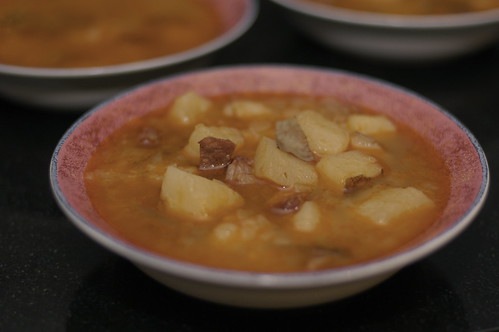| From CSA 2k8 |
- lots of peppers!
- celery
- turnips
- broccoli
- apples
- pears
- carrots
- onion
- radishes
- eggs
- mesclun
 |
| From CSA 2k8 |
The dried leaves are quickly toasted over a bare flame — they send off a wonderful fragrance. If you don’t have any available, you can always prevail upon friends who do in other parts of the country to send them, as they will keep for several months dried.

While paging independently at different times through Kennedy’s Art, Alex, Nick, and Sebastian – at least in my memory – all noted with interest this recipe for Oaxacan Black Beef Stew.
Chichilo negro is a dramatic stew of meat an vegetables in a fragrant and complex black sauce, redolent of black chiles and toasted avocado leaves. It is one of the more important of the Seven Moles of Oaxaca and prepared in the villages of the Central Valley on festive occasions instead of the much heavier black Oaxacan mole. In the past it was always made with the black, bulbous, thin-skinned chilhuacle negro, which in recent years have become scarcer and very expensive, so chiles guajillos, charred black, are now often used.
This is Mexican food at its most exotic!
Chichilo is best served in shallow bowls—meat, vegetables, and plenty of sauce, with the final touch (as if that were necessary) of rajas con limon (page 359). Some black beans cooked de olla (page 179) and corn tortillas accompany this dish, whichis not, surprisingly, very picante.
I’ve never cooked one of these before, so I'm excited for it. I bought a big spiky one, you know, just to make life more interesting.
The chayote, sometimes called a vegetable pear, is indegenous to Mexico and has been cultivated by the Indians for centuries; they gave it a Nahuatl name, chayutli.
Several varieties are grown in Mexico: small cream-colored ones, dark and light green ones with porcupinelike prickles, and then the light green, smoother variety, puckered at both ends, that is found in most Latin American markets in the US.
Only when the last variety is very tender and freshly picked can the skin be eaten; otherwise it should be discarded. But the seed, or flat almond, inside is a delicacy.
The chayote is a perennial climbing plant that grows profusely over the tall trees in my orchard, but it can be trained over a wire frame or cama when grown commercially. The tuberous root is edible and delicious, but it should be left to experts to dig it up without disturbing the reproductive part of the root system on which the following year's growth depends. The root, called camote de chayote, chinchayote, or chintestle, depending on the region, is boiled and eaten by itself or made into fritters and has a pleasant, earthy taste rather like that of the Jerusalem artichoke (Kennedy, p.147).
 |
| From CSA 2k8 |
The Vesevo 2004 Aglianico Beneventano is a dark ruby purple and offers a complex nose of black cherry, spice and cassis aromas. On the palate it exhibits rich extracted black fruit flavors, with smoke, leather, and mushrooms notes. Aged in barrique for six months, the big and seductive beauty has all the assets of a superb wine with great balance and ripe gripping tannins. A terrific wine at a great price.
I had the 2005 on a recommandation at the Wine Merchant in St Louis (we walked around the store looking at the $10–15 range and he hit all my usual favorites like Luzón and Juan Gil from Spain and NQN from Argentina). Perhaps more leather than mushroom but definitely my kind of earthiness and still a lot of concentrated fruit. I had it with beet ravioli, which played nicely off the earthy qualities. The first sip is a big burst of Italian-ness. I’ll be finishing it tomorrow at lunch with my favorite tuscan beans and tomatoes.
 amtrak authorization; metaphor for candidates. According to Wikipedia, “During the Shinkansen's 44-year, nearly 7 billion passenger history, there have been no passenger fatalities due to derailments or collisions (including earthquakes and typhoons).”
amtrak authorization; metaphor for candidates. According to Wikipedia, “During the Shinkansen's 44-year, nearly 7 billion passenger history, there have been no passenger fatalities due to derailments or collisions (including earthquakes and typhoons).”
 |
| From CSA 2k8 |